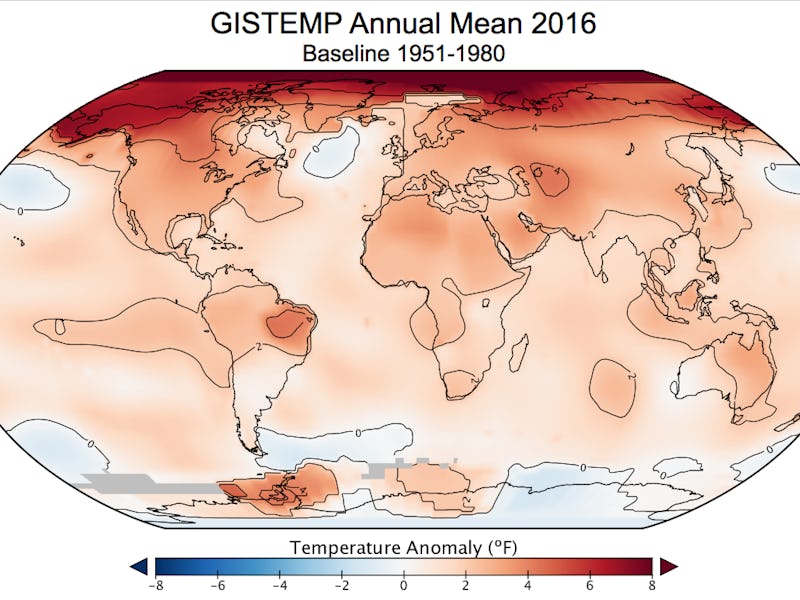Your Annual Reminder From NASA That Global Warming Is Real
Can we get on with the conversation about what to do about it?

Scientists jumped on a teleconference with reporters Wednesday to deliver some news: Yes, 2016 was the warmest year in recorded history; yes, the planet continues to warm as expected; and yes, climate change is real.
“The trends that we’ve been seeing since the 1970s are continuing, and have not paused in any way,” says Gavin Schmidt, director of NASA’s Goddard Institute for Space Studies.
According to NASA’s analysis (done in conjunction with the National Oceanic and Atmospheric Administration, or NOAA), 2016 came in 1.2 degrees Celsius above the pre-industrial average. It beat the previous record, set in 2015, which beat the record set in 2014. Each of those years was at least one degree above the late 19th-century average, and Schmidt doesn’t expect to see a year fall below that benchmark for the foreseeable future, barring some temporary cooling event caused by, perhaps, a large volcanic eruption.
It's getting hot in here.
This year, he says, will likely be cooler than the last, but not by much. “My personal prediction is that 2017 will be a top-five year, possibly the second warmest,” says Schmidt. “Whether people suddenly want to say after a record that, ‘Oh, now we’ve cooled, because there was a record last year’ — I think people are savvy enough to see how transparent that is.”
Of course, the unspoken context of this whole discussion was a rebuke of climate change deniers in a country set to inaugurate a president this week who has appointed leading climate change deniers to his cabinet, and has signaled intentions to gut NASA’s budget for climate change science.
El Nino changes things, but enough to derail the trend.
But that’s not what scientists came to talk about.
“We prepare these data and these analyses to share with the American people, and that’s what we do,” said Deke Arndt with NOAA, after a pregnant pause, in response to a repeated question on the scientists’ message to the incoming Donald Trump administration.
The science, at least in an ideal world, speaks for itself.
Schmidt and Arndt presented their case via 12 charts and graphics, via Arctic and Antarctic sea ice data, and snowfall records. They compared analyses between the organizations, but also with several other independent sources. They spoke of uncertainty, though their conclusion was firm. “These data sets are all singing the same song, even if they’re hitting different notes along the way — the pattern is very clear,” says Arndt.
And yes, the trend is almost entirely due to human causes, and largely fossil fuel burning “Effectively, the natural component over this time period is very close to zero,” says Schmidt. “Pretty much all of the long-term trend we’ve seen is in fact attributable to human activity.”